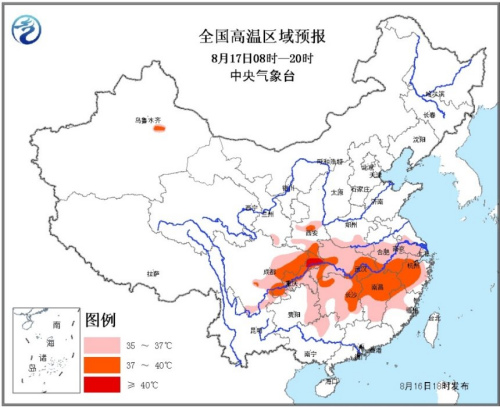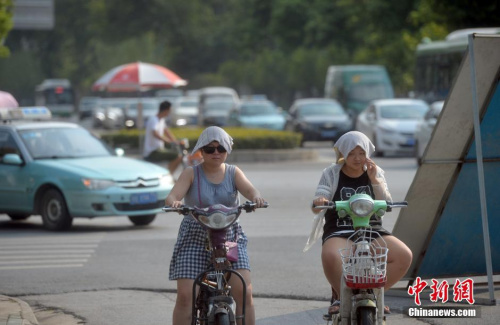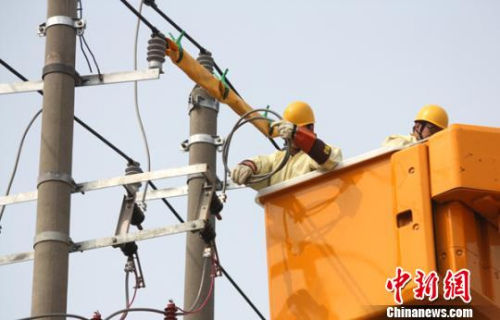"Autumn Tiger" continues to occupy the central and eastern regions, and the high temperature approaches 40 degrees.
BEIJING, Beijing, August 17 (Xinhua) In recent days, a large range of high-temperature weather has occurred in the central and eastern parts of China, and extreme temperatures above 40℃ have even occurred in some places. According to the forecast of the meteorological department, in the next 10 days, there will be 5-8 days of high temperature weather in the western part of Huanghuai, Jianghan, Jianghuai, most of the south of the Yangtze River, the eastern part of Sichuan Basin and Guanzhong, Shaanxi Province, and the daily maximum temperature in some areas can reach 37-39℃.

On August 7th, China officially ushered in the beginning of autumn solar term. However, after that, many places in the country did not welcome the crisp autumn weather, but frequently encountered "autumn tigers", and the Central Meteorological Observatory continued to issue a yellow warning of high temperature.
China Weather Network reported that on the 11th, with the strong return of subtropical high, large-scale high temperature weather reappeared in the central and eastern regions. On the 15th, high temperatures occurred in seven provincial-level cities, including Xi ‘an, Hefei, Wuhan, Nanjing, Hangzhou, Nanchang and Chongqing, among which the hot weather in Chongqing and Hefei has lasted for six days.
At 18: 00 on the 16th, the Central Meteorological Observatory continued to issue a high-temperature yellow warning. It is estimated that during the daytime on August 17th, there will be high temperature above 35℃ in southeastern Gansu, Guanzhong and southern Shaanxi, southern Henan, central and southern Anhui, southern Jiangsu, most of Zhejiang, western Fujian, most of Jiangxi, most of Hubei, most of Hunan, most of Sichuan Basin, Chongqing, eastern Guizhou, northwestern Guangxi and Tutuo Basin.
Among them, the highest temperature can reach 37 ~ 40℃ in parts of southern Shaanxi and Guanzhong area, central and eastern Sichuan basin, central and western Chongqing, eastern Hubei, eastern Hunan, southern Anhui, central and northern Jiangxi, western Zhejiang, northwestern Fujian, and Tutuo basin.
The medium-term forecast shows that in the next 10 days, it is expected that there will be 5-8 days of high temperature weather in western Huanghuai, Jianghan, Jianghuai, most of the south of the Yangtze River, eastern Sichuan Basin and Guanzhong, Shaanxi Province, and the daily maximum temperature in some areas can reach 37-39 C.
On the whole, although the area and intensity of this round of high temperature are not as good as the high temperature process from late July to early August, it is still sultry because of the high air humidity. Although it is already in beginning of autumn, the summer heat is hard to disappear.

Chongqing’s three-day continuous high-temperature red police in Hubei started emergency response.
"Furnace" Chongqing is the "hardest hit" of this round of high temperature weather. On the 16th, Chongqing sounded the red warning of high temperature for the third consecutive day, and extreme high temperatures above 40 C occurred in many local districts and counties.
According to statistics from the local meteorological department, since late July, the number of high temperature days in Chongqing has been 20% more than that in the same period of normal years, while the precipitation has been 20% less than that in the same period of normal years. In some districts and counties of northeast and west Chongqing, there are outcrops in the summer drought, and the trend of soil moisture deficiency is intensified.
Since August 11th, Hubei has also experienced a new round of high temperature weather. The highest temperature in most areas has risen from 35℃ to above 37℃, and in some areas it has reached about 39℃. Several warning signals of high temperature yellow and orange have been issued.
At 10: 00 on the 16th, emergency headquarters, a meteorological disaster in this province, launched a three-level emergency response to meteorological disasters (high temperature). At 11: 00, the Hubei Meteorological Bureau launched a high-temperature three-level emergency response.
Wuhan, which is also a "stove" city, also issued a high-temperature orange warning for the fifth consecutive day on the 16th. The high temperature in the past few days has made the public call "unbearable heat".

High temperature weather has led to an increase in electricity consumption, and the electricity load in many areas has set a new record.
At 15: 10 on the 16th, the maximum load of Chengdu power grid reached 9.848 million kilowatts. Since the summer of this year, the power grid load of the city has reached a record high for the fourth time.
The load of the power grid continued to rise, which made the transformers of several substations in Chengdu overloaded or even overloaded on the 16th. The oil temperature of the main transformer approached the warning value, and several tidal current sections exceeded the limit. All operating units of Chengdu Power Supply Company have strengthened inspection and temperature measurement, and taken measures such as water washing and ice cooling to ensure the reliable operation of the equipment.
Just the day before, Wuhan also ushered in the largest power grid load in history. At 13: 20 on the 15th, the largest power load of Wuhan Power Grid exceeded 10 million kilowatts, reaching 10.1102 million kilowatts, up 21.07% year-on-year.
Previously, Wuhan Power Supply Company had predicted that the maximum load of the power grid would appear from late July to early August this summer, and the maximum power load might reach more than 9.2 million kilowatts, but this time it actually exceeded 10 million kilowatts, which is also the seventh high this summer.
In addition, the power load of Shandong Power Grid and Xi ‘an Power Grid also broke through the historical record.

Although the continuous high temperature in many places has caused many netizens to shout "The autumn tiger is in full swing!" However, meteorologists believe that the current high temperature in the middle and lower reaches of the Yangtze River is not an "autumn tiger".
Some experts have previously analyzed that "autumn tiger" is a common name of China people for the short-term hot weather that reappears after beginning of autumn, which usually occurs at the turn of August and September and lasts for about 7-15 days.
Although the "autumn tiger" is fierce, the temperature difference between day and night is relatively increased wherever it goes, and the air humidity will be lower than that in summer. Therefore, although the temperature is high during the day, it is cooler in the morning and evening, and the feeling of damp heat is not as strong as that in summer, so it will not be too hot to make people breathless.
At present, most parts of central and eastern China, including Wuhan, are still under the influence of subtropical high, and it is still in the dog days of summer without autumn.
In fact, in climatology, the moving average temperature for five consecutive days has steadily dropped below 10℃, which means that autumn has arrived.
The reporter checked the information and found that many areas have to wait until after September in the autumn season. For example, the autumn time in Beijing all the year round is September 9. Last year, the autumn time in Beijing was September 4, five days earlier. The average autumn time in Wuhan is in the middle and late September. (End)